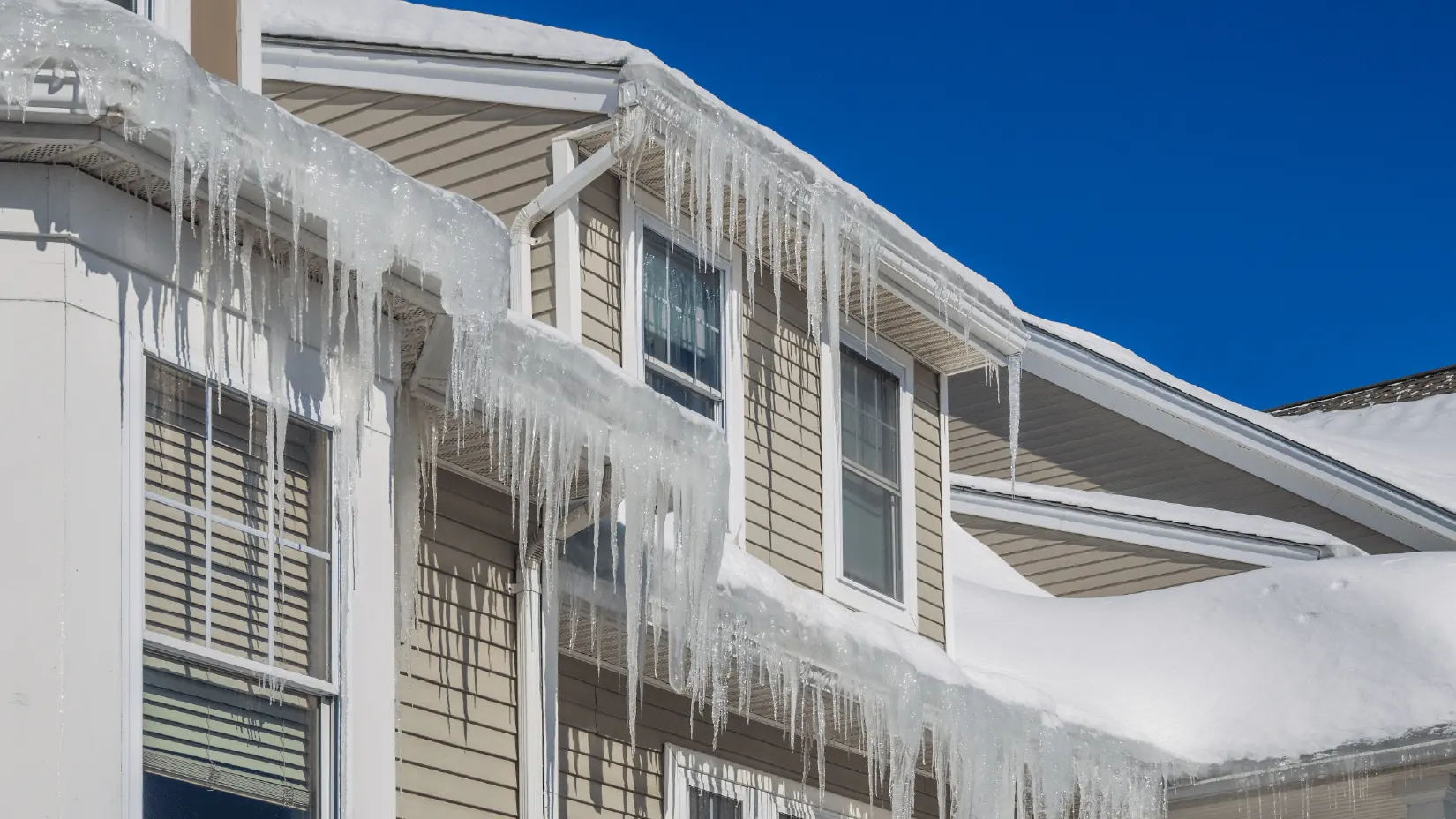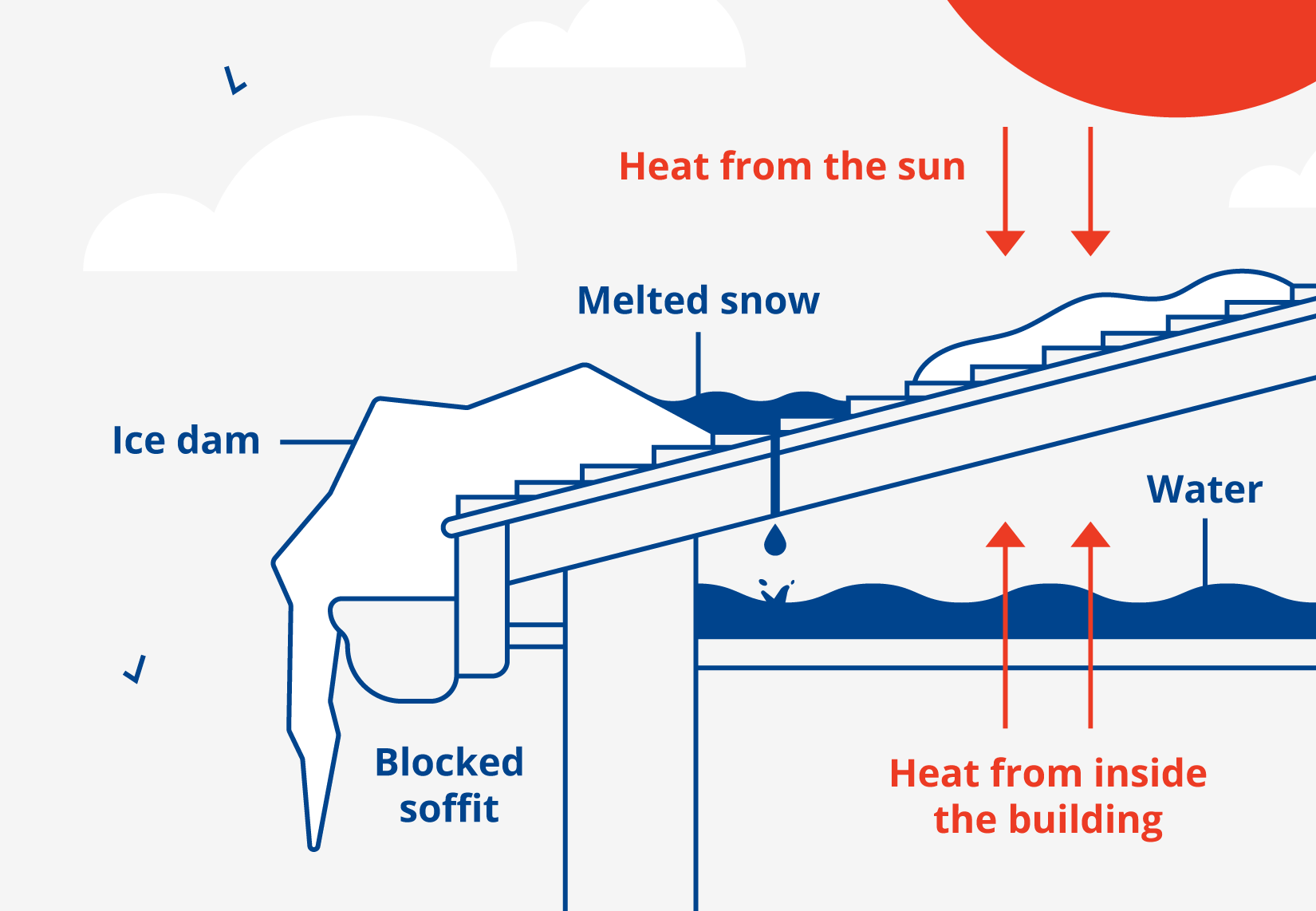
Last Updated: April 11, 2024
An ice dam is a ridge of ice that forms at the edge of a roof, preventing melting snow from draining properly and potentially causing damage to the building by allowing water to seep into the structure, leading to issues such as roof leaks and compromised structural integrity.
Those who live in a cold climate prone to snow and ice storms have likely heard the term “ice dam” before. But what is an ice dam, and is it really something to worry about?
An ice dam is a barrier of ice that forms along the edge of a roof, hindering proper drainage of melting snow. Enough snow and ice buildup can lead to a range of issues, from roof leaks to structural damage.
This article delves into what causes ice dams, the damage they can inflict on commercial and residential properties, and provides valuable tips on how to prevent ice dams from forming in the first place.
What Causes Ice Dams?
Ice dams form due to a combination of several factors. Rapid changes in weather, such as daytime warming followed by nighttime freezing, causes the snow on the roof to melt and refreeze, creating a block of ice along the eaves of a building.
Factors that contribute to the formation of ice dams include:
- Outdoor temperature fluctuations: Rapid temperature changes, particularly when daytime temperatures lead to partial snow melt on the roof, followed by nighttime freezing, can initiate ice dam formation.
- Inadequate roof ventilation: Poor ventilation in the attic can trap warm air, warming the roof's upper surfaces. This warmth promotes the melting of snow, which then refreezes at the colder eaves.
- Poor attic insulation: Insufficient insulation allows heat from the interior to penetrate the attic space, warming the roof and contributing to the uneven melting and refreezing of snow.
- Clogged gutters: Debris and ice buildup in rain gutters prevent proper water drainage, facilitating the formation of ice dams as melted snow has nowhere to go.
- Snow buildup on the roof: Excessive snow buildup on the roof provides ample material for ice dam formation, especially when melting and freezing cycles occur.

Potential Ice Dam Damage
When ice dams form, they prevent the water from melting snow and ice from running normally off a roof and into the gutters. As water builds up, it can work its way under a building’s shingles or other roofing materials, eventually entering the interior and causing damage.
Potential ice dam damage includes:
- Roof leaks: The trapped water behind the ice dam can seep under roofing materials, causing leaks that compromise the integrity of the roof structure
- Interior water damage: Leaks resulting from ice dams can infiltrate interior spaces, damaging ceilings, walls, insulation, and even personal belongings.
- Gutter and downspout damage: The weight and pressure of ice dams can strain gutters and downspouts, causing them to detach or break.
- Mold and mildew growth: Moisture entering the building can create a conducive environment for mold and mildew, posing health risks to occupants and requiring costly remediation efforts.
- Structural damage: Over time, the repeated freeze-thaw cycles associated with ice dams can compromise the structural integrity of a building, leading to long-term damage.
How To Identify Ice Dams
Recognizing an ice dam on a building's roof is vital for both residential and commercial structures to prevent potential damage.
- Note the presence of icicles: One of the earliest telltale signs is the presence of icicles hanging from the roof edge, particularly if they extend beyond the gutter. This often indicates that melted snow is refreezing at the eaves, potentially forming ice dams underneath.
- Look for water stains: Additionally, visible water stains on interior ceilings and walls, particularly near the roofline, can suggest that water is infiltrating the building due to ice dams.
How To Prevent Ice Dams
Occupants and property managers should take a proactive approach to avoid ice dams. By addressing key elements such as proper insulation, adequate roof ventilation, and regular maintenance, occupants can significantly reduce the risk of ice dams.
Here are a few preventative measures to take:
1. Roof Raking
Whenever there’s snowfall of 6 inches or more, a specialty roof rake can be used to remove the snow from the roof. This can be extremely dangerous, especially in wet, icy conditions. It is critical to proceed with caution and to have the proper equipment and safety measures in place before beginning.
2. Professional Snow Removal
Trained snow removal professionals have the expertise and equipment to safely and thoroughly clear snow buildup from roofs, ensuring that the weight and moisture associated with snow are promptly eliminated. By proactively removing snow, there’s less risk of it melting and refreezing at the eaves.
3. Improve Attic Insulation
A properly insulated attic helps prevent ice dams from forming by keeping pockets of warm air that would otherwise escape from the attic away from the snow. When warm attic air escapes, it can melt snow, which refreezes as it pools at the edge of the roof. Have a professional inspect the insulation in the building and make recommendations on how to improve it to protect the roof.
4. Clear Gutters
Regular gutter maintenance is a key element in preventing ice dams on your roof. Clearing debris such as leaves and twigs from the gutter ensures proper water drainage and minimizes the risk of water pooling and subsequent freezing.
When gutters are clogged, melted snow has no clear path to escape, creating the perfect conditions for ice dam development. It is recommended to clean gutters at least twice a year — once before the winter season and again in the spring — to remove debris and maintain optimal water flow.

Ice Dams FAQ
Does an Ice Dam Mean I Need a New Roof?
The presence of an ice dam doesn't automatically necessitate a new roof. However, if ice dams are recurrent and lead to water damage, it could accelerate the aging process of the roof. Preventive measures, such as improving insulation and ventilation and performing regular gutter maintenance, can minimize the impact of ice dams and extend the lifespan of your existing roof.
How Do You Know If You Have an Ice Dam?
An ice dam can typically be identified by the presence of large icicles hanging from the roof’s edge, especially if they extend beyond the gutter. Interior indicators, such as water stains on ceilings or walls near the roofline, may also suggest ice dam-related issues.
Additionally, patches of ice along the roofline or water leakage from your roof during winter months are also a good indication that there may be an ice dam on the roof.
How Do Ice Dams Cause Roof Leaks?
Ice dams can cause roof leaks when melted snow is unable to drain off the roof due to the dam's barrier. As the trapped water accumulates behind the ice dam, it can find its way under the roofing materials, such as shingles or flashing. Once beneath the roof's surface, the water can infiltrate the building, leading to leaks, water stains, and potential structural damage if left unaddressed.
Rainbow Restoration® Can Help With Water Damage
Understanding what an ice dam is, recognizing the signs of its presence, and taking steps to prevent it is crucial for protecting a residential or commercial building during the winter.
If your residential or commercial property has suffered water damage or types of mold from an ice dam, your local Rainbow Restoration is here to help. The IICRC-certified professionals at Rainbow Restoration understand the importance of immediate remediation and reconstruction to help you recover as quickly as possible.
Contact the Rainbow Restoration location nearest you for restorative services.
This article is intended for general informational purposes only and may not be applicable to every situation. You are responsible for determining the proper course of action for your property. Services should be performed by licensed and experienced professionals. Rainbow Restoration is not responsible for any damages that occur as a result of this blog content or your actions. For the most accurate guidance, contact a Rainbow Restoration professional for a custom, on-site assessment.
